Why do we need road works?
What causes tarmac to crack?
Roads degrade in a number of different ways and therefore roadworks are a necessary part of maintaining our roads.
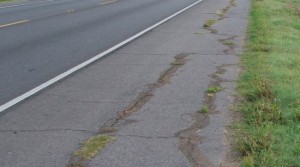 Edge cracks
Edge cracks
These are lateral lines along the edge of the road, like the tarmac is falling away. It can be caused by a lack of drainage, vegetation growing into the edge of the tarmac, settlement of the underlying material, a weak base or subgrade layer, heavy traffic along the edge (such as agricultural traffic that might keep hard left as not to hold up the general flow of traffic), and frost heave (where water in the ground expands and contracts, lifting and dropping the asphalt).
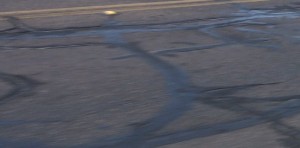 Block cracking
Block cracking
Block cracking is where you get rectangular cracks appearing and can be fixed with a thin overlay or specific treatment of the crack. It’s caused by road workers placing the mix too dry, or it just happens as the road gets old. Unusually, it’s made worse by low traffic volumes.
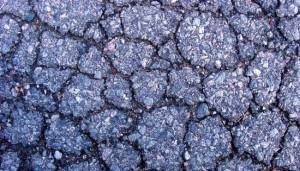 Fatigue cracking
Fatigue cracking
This type of cracking is also called alligator cracking because it creates lots of small cracks that look like reptile scales. It’s caused by excessive heavy traffic, poor drainage and a thin or weak surface or base. The tarmac needs to be taken up and replaced at full depth.
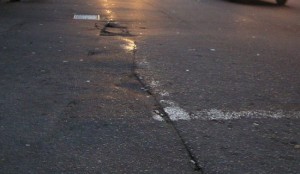 Longitudinal cracks
Longitudinal cracks
These cracks happen down or near to the centre of the road as they are mostly caused by poorly constructed paving joints. They are aggravated by daily temperature shifts and can also be caused by shrinkage or cracking in an underlying layer. Trapped water can make this worse. The cracks can be fixed with sealing with an asphalt emulsion.
Slippage cracking
These are like a graze where a portion of the tarmac slips. If the mixture was laid with a high sand content, or some material such as water, dust or oil has got beneath the surface, there’s not enough grip between the surface layer and the base. It is often initially caused by a heavy vehicle turning or stopping suddenly where there’s an existing weakness. It needs to be fixed with a full depth patch
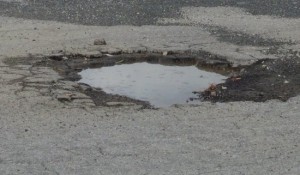 Pot holes
Pot holes
A pot hole starts with a small failure in the surface and gradually this is widened by the action of vehicles, frost, and running water as pieces around the edge of the hole become dislodged. They can be filled. Unlike cracks, pot holes can damage your vehicle’s suspension or tyres.

There are other pavement issues that can arise such as bleeding, loss of aggregate, settlement depressions where large puddles can form (like the image on the left), corrugations and rutting. Corrugations and rutting tend to happen more frequently on roads that are not sealed. All need to be fixed by using roadworks and this is covered in Rule 288 in the Highway Code:
When the ‘Road Works Ahead’ sign is displayed, you will need to be more watchful and look for additional signs providing more specific instructions. Observe all signs – they are there for your safety and the safety of road workers.
- You MUST NOT exceed any temporary maximum speed limit.
- Use your mirrors and get into the correct lane for your vehicle in good time and as signs direct.
- Take extra care near cyclists and motorcyclists as they are vulnerable to skidding on grit, mud or other debris at road works. Where lanes are restricted due to road works, merge in turn (merge like a zip).
- Do not drive through an area marked off by traffic cones.
- Watch out for traffic entering or leaving the works area, but do not be distracted by what is going on there. Concentrate on the road ahead, not the road works.
- Bear in mind that the road ahead may be obstructed by the works or by slow moving or stationary traffic.
- Keep a safe distance – there could be queues in front.
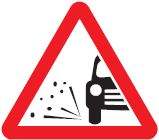 While roads are being repaired there may be temporary or permanent signs indicating that there’s the likelihood of loose gravel/aggregate being flicked up while driving. This poses a risk to other drivers’ windscreens, and you might see this sign.
While roads are being repaired there may be temporary or permanent signs indicating that there’s the likelihood of loose gravel/aggregate being flicked up while driving. This poses a risk to other drivers’ windscreens, and you might see this sign.
Motorcyclists should take extra care around road works as gravel and potholes are much more difficult to ride on.
Questions on road works are covered in the hazard awareness section of the Highway Code, and you can try questions here.
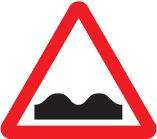 Where there are permanent dips in the road that can’t be fixed by roadworks you will see this sign that indicates the road has undulations.
Where there are permanent dips in the road that can’t be fixed by roadworks you will see this sign that indicates the road has undulations.
Posted in Car, Heavy Vehicle, Highway Code, Motorbike, Passenger Vehicle
0 comments on “Why do we need road works?”
1 Pings/Trackbacks for "Why do we need road works?"
- Understanding the National Standards for Riding Mopeds and Motorcycles
- Livestock Transport Rules UK: A Complete Guide to Animal Transportation Requirements
- The Role of Safety Advisers in Dangerous Goods Transport
- Sustainable Driving: Reducing Your Environmental Impact on the Road
- Developing Effective Lesson Plans for Driver Training
- UK Agricultural Vehicle Registration and Tax Relief
- Challenges of Transporting Radioactive Materials (Class 7)
- Exemptions and support for Clean Air Zone charges
- Navigating Legal Requirements: The UK Motorcycle Licensing Rules
- Safe Transportation of Agricultural Chemicals and Hazardous Materials
- Innovations in Vehicle Construction for ADR Compliance
- Motorcycle Recovery Operations: How to Recovery a Broken Down Motorbike
- Alternative Fuels in Agricultural Vehicles
- Carriage of Dangerous Solids in Bulk Containers
- Understanding Limited Quantity Exemptions in ADR

[…] Read more about the different types of tarmac degradation here. […]